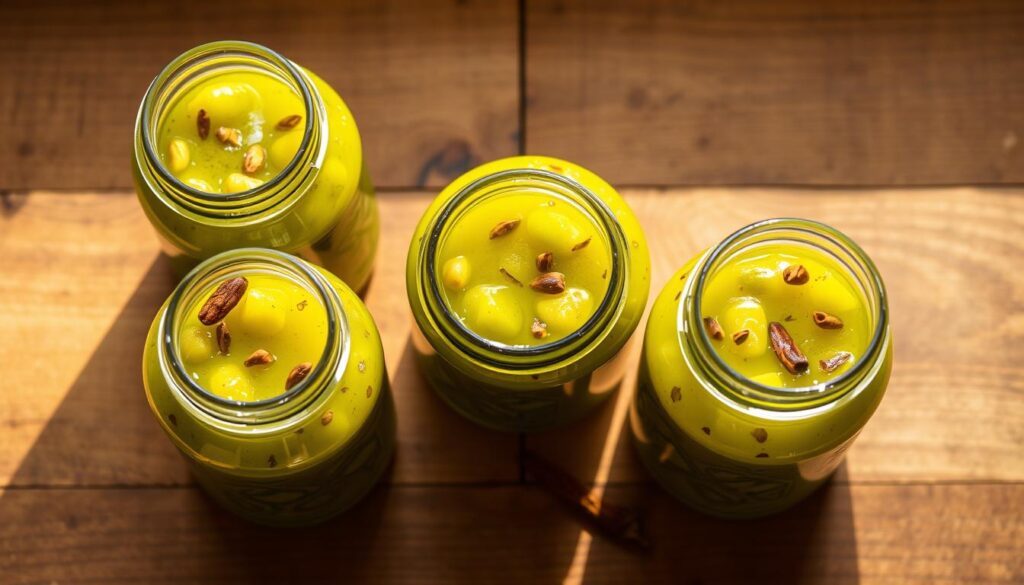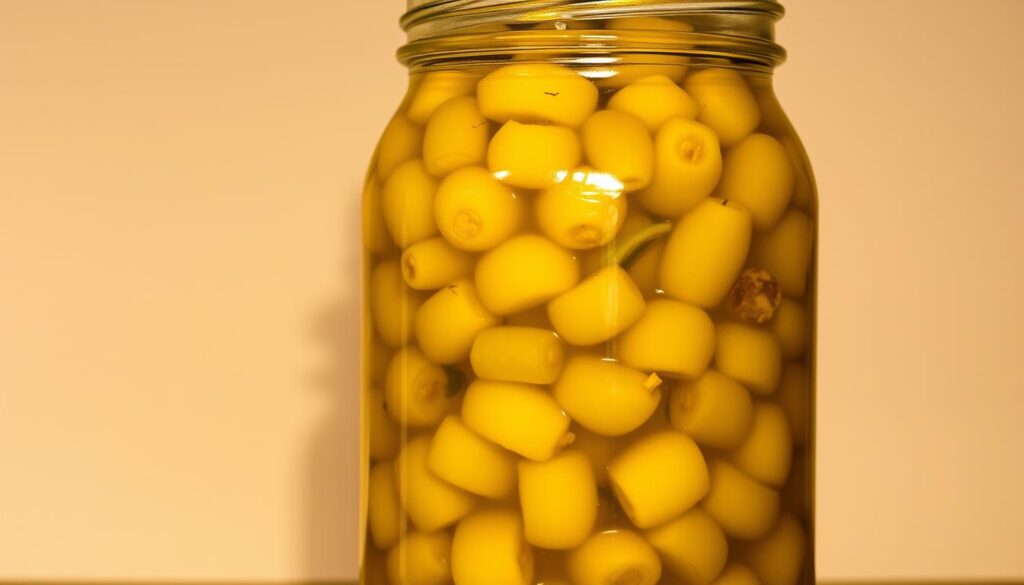Table of Contents
I still remember my grandmother’s traditional Indian pickling recipes with lime no oil. She made them with love and care. Her authentic Indian lime pickle recipe was a staple in our household. I’m excited to share a healthier version with you.
This recipe lets you enjoy Indian flavors without sacrificing health. It’s easy to make and needs only a few ingredients. I’m thrilled to share this recipe with you. I’m sure you’ll love it just as much as I do.
Key Takeaways
- Learn how to make authentic Indian lime pickle recipe with no oil
- Discover the benefits of Indian pickling recipes with lime no oil
- Get tips on selecting the right ingredients for your pickle
- Understand the importance of fermentation in pickle making
- Find out how to store your pickle for maximum shelf life
- Explore different serving suggestions and pairing ideas
- Learn how to troubleshoot common pickle problems
Understanding the Art of Indian Pickling Recipes with Lime No Oil
I’m excited to dive into Indian pickling recipes, focusing on traditional and oil-free methods. The traditional indian lime pickle has been a key part of Indian food for ages. Now, we can make tasty and healthy pickles without oil.
Making pickles is an art that needs patience, skill, and the right tools. For a traditional indian lime pickle, you need fresh limes, spices, and more. But, the no oil lime pickle method makes it easier and healthier.
- Reduced calorie intake
- Increased shelf life
- Improved flavor and texture
Next, we’ll look at picking and preparing limes for the pickle. We’ll also see how to mix the perfect spices for both traditional and no oil lime pickles.
Selecting and Preparing Your Limes
For a tasty homemade lime pickle no oil, the right limes are key. Look for limes that are firm, heavy, and bright green. They should smell sweet and a bit tangy.
Washing and drying your limes is crucial before pickling. This removes dirt, wax, and bacteria. Wash them under water, then dry with a towel to avoid moisture issues.
After cleaning, slice your limes. For a traditional pickle, cut them into thin wedges or rounds. Make sure to remove seeds and pulp to avoid bitterness.
Here are some tips for selecting and preparing limes:
- Choose limes without blemishes or soft spots
- Use a sharp knife to slice limes to avoid tearing
- Remove excess moisture before slicing to prevent sogginess
By following these steps, you’ll make a delicious homemade lime pickle no oil. It’s great for snacking or adding to dishes.
Essential Spices and Ingredients for Your Healthy Pickle
To make a tasty and healthy Indian lime pickle, you need the right spices and ingredients. When I make an easy Indian lime pickle recipe, I pick the freshest limes and key spices. The main spices are turmeric, red chili powder, and coriander seeds. They add flavor and health benefits.
A spicy lime pickle recipe needs a mix of spices that work well together. Important ingredients include:
- Ginger and garlic for extra flavor and health perks
- Fenugreek seeds for their unique taste and texture
- Mustard seeds for a flavor boost and crunch
Choosing the right salt is crucial. I use sea salt or Himalayan pink salt for better flavor and texture. The right salt amount is key to your pickle’s taste.
Here’s a simple table to help you start your spice blend:
| Spice | Quantity |
|---|---|
| Turmeric | 1 teaspoon |
| Red chili powder | 1/2 teaspoon |
| Coriander seeds | 1 tablespoon |
Step-by-Step Pickling Process
To make a tasty healthy lime pickle recipe, follow a simple process. Start by preparing the limes, mixing the spice blend, and setting up for fermentation. The goal is to get the pickles just right: tangy, spicy, and crunchy.
Begin by washing and slicing the limes thinly. Remove seeds and excess pulp. Then, mix the spice blend, which includes turmeric, red chili powder, and mustard seeds. This blend is what makes the healthy lime pickle recipe special.
After preparing the spice blend, create the pickling liquid. Mix it with water, salt, and sometimes sugar or honey. The liquid should be tangy and slightly sweet. Place the limes in a jar, then pour the liquid over them, covering them completely.
When making a healthy lime pickle recipe, use fresh ingredients. Adjust the spice blend to your liking. Also, watch the fermentation to keep the pickles tangy and flavorful. With these tips, you can make a delicious healthy lime pickle recipe for snacking, cooking, or sharing.
Mastering the Fermentation Timeline
To make a tasty lime pickle, knowing the fermentation process is key. I’ve found that patience and detail are crucial. The time it takes can change based on temperature, salt, and lime type.
When making tangy lime pickle, watch the fermentation closely. Signs of proper fermentation include a sour smell, tangy taste, and bubbles. Check these signs often to make sure your pickle is fermenting right.
Monitoring the Fermentation Process
- Check the pickle’s texture and taste regularly
- Look for signs of mold or yeast growth
- Adjust the salt levels or temperature as needed
By following these tips, you can make a tangy lime pickle that’s great for snacking or as a side. Always use fresh, high-quality ingredients for the best taste and texture.
Storage Tips and Shelf Life

After making your authentic indian lime pickle recipe, it’s important to store it right. This keeps its taste and texture good. For indian pickling recipes with lime no oil, how you store it affects how long it lasts.
Put your pickle in a clean, airtight container. This stops germs and keeps it fresh. Store it in the fridge to slow down the fermentation.
- Keep the container away from direct sunlight and heat sources.
- Always use a clean spoon to scoop out the pickle.
- Monitor the pickle’s condition regularly and remove any signs of mold or spoilage.
Follow these tips to enjoy your authentic indian lime pickle recipe longer. Always check the pickle before eating it. If it’s spoiled, throw it away.
Serving Suggestions and Pairing Ideas
There are many ways to serve traditional indian lime pickle. It goes well with both traditional Indian dishes and modern recipes. It’s like a flavor booster that makes any meal better.
Looking at recipe websites can spark new ideas. You can top burgers or salads with it for a citrus kick.
Classic Pairings
Classic pairings for traditional indian lime pickle include naan bread, tandoori chicken, and basmati rice. These are favorites in Indian cuisine and are loved by many.
Modern Twists
For something new, try no oil lime pickle on grilled meats or veggies. It’s also great in sauces or marinades. Here are some ideas:
- Top tacos or grilled fish with traditional indian lime pickle.
- Mix no oil lime pickle into yogurt or sour cream for a tasty dip.
- Add traditional indian lime pickle to soups or stews for extra flavor.
Troubleshooting Common Pickle Problems

When making homemade lime pickle without oil, you might face some challenges. I’ve learned from my own easy Indian lime pickle recipe that avoiding these problems is crucial. Keeping your environment clean and using the right ingredients helps prevent mold and other issues.
Common problems include mold, loss of crispness, and flavor imbalances. To avoid these, watch the fermentation process closely and adjust as needed. Here are some tips to help you fix common pickle problems:
- Keep your equipment and workspace clean to prevent contamination and mold growth.
- Use the right amount of salt and spices to maintain the perfect balance of flavors.
- Monitor the fermentation process closely to ensure that your pickle is developing the right flavor and texture.
By following these tips and being aware of potential issues, you can make a tasty and healthy homemade lime pickle. Stay alert and adjust as needed to get your pickle just right.
Conclusion: Embracing Healthy Traditional Flavors
As we finish our journey through making authentic spicy lime pickle, I hope you’re inspired. You’ve learned to make a delicious, healthy condiment. This is a taste of India’s rich culinary traditions.
Making this oil-free pickle might seem hard at first. But now, with our guide, you can make your own tasty pickles. You can use them with your favorite Indian dishes or in new recipes. These pickles will make your meals better and more exciting.
Keep exploring healthy traditional flavors and enjoy pickling. It’s simple and lets you make flavors you love. Dive into India’s culinary heritage and let your taste buds lead the way on a fun food journey.

